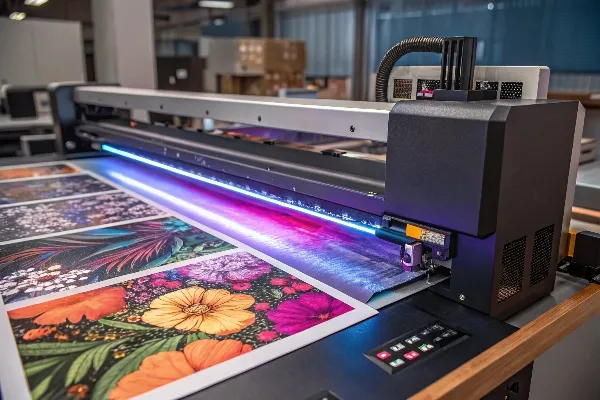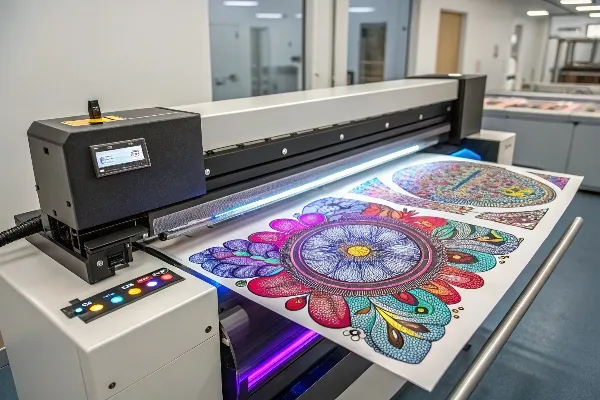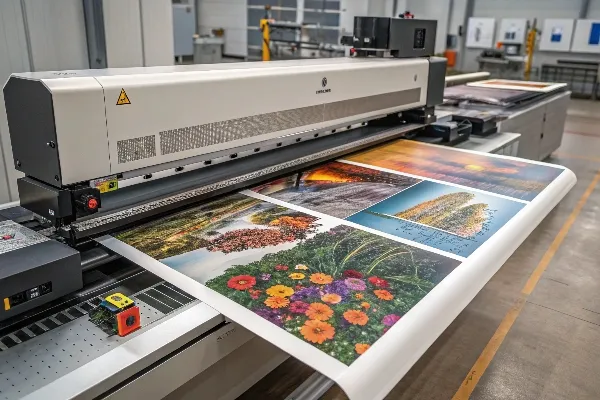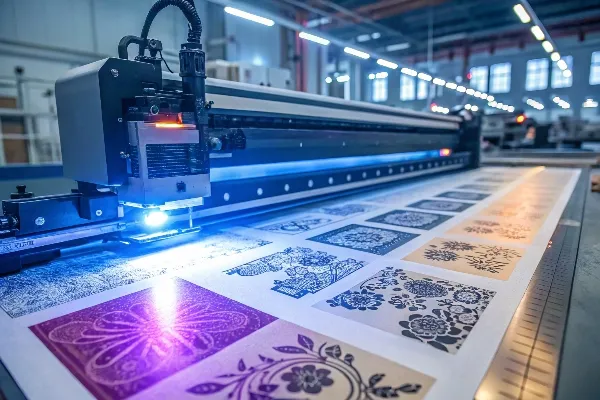Avoid your inquiry is delay response, please enter your WhatsApp/WeChat/Skype along with the message, so we can contact you at the very first time
We will reply you within 24 hours. If for urgent case, please add WhatsApp: +8617888313102, or WeChat: +86 17864107808. Or call +86 17864107808 directly.
*We respect your confidentiality and all information are protected. We will only use your information to respond to your inquiry and will never send unsolicited emails or promotional messages.
I often meet people who struggle to print on unconventional surfaces. They want consistent colors and durable finishes. They feel frustrated when old methods fail on complex materials.
An UV printer machine uses ultraviolet light to cure special inks. This process allows the ink to bond quickly to materials such as wood, plastic, or metal. It creates high-quality, fast-drying designs.

UV printer machine
I became fascinated with UV printers when I realized they solve many printing challenges. I remember watching a friend struggle with delayed projects because of slow ink drying or smudges. Then we discovered this technology. Now, I work with a team at Sena Printer to bring modern UV solutions to professionals around the world.
I see confusion when people first hear about UV printing. They often assume the machine uses laser-like beams alone to create images. They worry about how the colors appear on the surface.
Yes, a UV printer does need ink. The ink is specially formulated to cure under ultraviolet light. This helps it stick to the material almost instantly, avoiding streaks or drips.

Does UV printer need ink?
I have been part of the printing industry for over 16 years at Sena Printer. My team members and I focus on the manufacturing of UV flatbed printers, flexible material printers, and automated features that save time. In my early days, I was unsure about UV ink. I had used solvent-based inks for years. However, I soon realized that those older inks took longer to dry. They also released stronger odors and, in some cases, they created more chemical waste. That changed once I saw how quickly UV ink cures when exposed to ultraviolet lamps.
Today, my colleagues and I design UV printers that handle various ink configurations. We often provide white ink modules for printing on transparent or dark materials. Our printers also include fixative layers to ensure the final design remains vibrant. I worked with John, a packaging company owner in the United States, who needed consistent color accuracy for food boxes. He emphasized brand imagery. He also needed to print on metal containers for specialized cosmetic items. Each time, the special UV ink and immediate curing solved alignment and drying issues.
The key reason UV printers require ink lies in their operation principle. These printers do not rely on just heat or evaporation to dry the ink. Instead, the ultraviolet lamps trigger a photochemical reaction. That reaction transforms the liquid ink into a solid film. It is faster, more precise, and less prone to smudges. In practice, every UV printer includes separate ink cartridges. Some models even automate nozzle cleaning to handle different job sizes without clogs. As a result, the final prints are vibrant and durable.
Below is a short comparison table to illustrate how UV printer ink stands against traditional ink:
| Characteristic | UV Ink | Traditional Ink |
|---|---|---|
| Drying Process | Cured by UV light | Evaporation or absorption |
| Drying Time | Almost instant | Moderately long |
| Odor | Minimal | Sometimes strong |
| Material Compatibility | Versatile (metal, glass) | Often limited |
| Resistance to Smudging | High | Moderate |
If you consider investing in UV printers, you need to understand the ink setup. Sena Printer’s machines include automatic color calibration to ensure consistent results. That approach is especially helpful in industries like packaging, where brand color identity is vital.
Sometimes, I get asked why a person should choose a UV printer over older printing technologies. Customers hesitate because of cost or setup complexity. They want to know if the printer will pay off quickly.
A UV printer offers faster curing, higher color accuracy, and the ability to print on many materials. Its main advantages include quick turnaround and a more eco-friendly approach.

What is the advantage of UV printer?
I have tested numerous printing technologies. I remember using older inkjet printers for custom packaging. These printers took up a lot of time. I lost hours waiting for ink to dry, and occasional smears lowered the final quality. Then came UV printing, and it changed everything.
First, speed is a big advantage. The UV-curing lamps instantly harden the ink, which results in almost no drying time. This rapid process helps me finish orders faster, especially during peak seasons. In my facility, I have seen entire runs of promotional items completed in half the time I used to need. That efficiency helps me deliver more orders for many clients, including those as demanding as John, who handles packaging for high-volume industries like food and cosmetics.
Second, UV printers accommodate a wide variety of rigid and flexible materials. Traditional printers often fail when faced with metals, acrylic, or thick plastic. By contrast, a UV flatbed printer from Sena Printer can handle everything from small phone cases to large wooden panels. Our brand has over 16 years of experience, so we have fine-tuned these machines to meet different industrial demands. We also export our products to over 80 countries, offering after-sales support and customized design services.
Third, UV printing is more environmentally friendly. My older printers used solvent-based inks that sometimes emitted unpleasant fumes. UV printing reduces volatile organic compounds because curing is immediate. This also reflects well on my clients who prioritize safety and eco-friendly processes. In many industries, such as packaging, sustainability is important for brand image. Clients often prefer to work with suppliers who use green processes.
Finally, color accuracy stands out. The ink cures without soaking into the material. This helps the color remain crisp and stable over time. For John’s packaging designs, brand logos and color consistency are critical. UV printing ensures each run looks the same, even across large production volumes. With advanced color calibration, the final output stays reliable.
All these advantages justify the investment in a UV printer. My own experience at Sena Printer shows that the time saved and the quality delivered lead to satisfied partners. The technology also keeps evolving, which is why we include features like automatic nozzle cleaning. This approach further reduces human error and downtime. I believe that a person seeking versatility, speed, and environmental benefits will appreciate a UV printer.
When I show people a UV printer, they wonder how the ink solidifies so fast. They see ultraviolet lamps shining on the surface. They ask if it is magic or science.
The UV printer’s principle is to project special ink onto a material, then use UV lamps to quickly cure that ink. This creates an instant bond and vibrant output.

What is the principle of UV printer?
To understand this principle, I look back at my first UV printer purchase. I had used older printers before, where ink dried through evaporation. I noticed the final result was sometimes dull because the ink would seep into porous surfaces. It also took a lot of time if I tried printing on glass or metal. Then I learned about photoinitiators in UV ink.
A UV printer contains specialized ink loaded with compounds called photoinitiators. These compounds stay in liquid form until they encounter intense ultraviolet light. When the printer’s UV lamp shines on the ink droplets, the photoinitiators absorb that light energy. They undergo a chemical reaction that bonds the ink molecules together, turning them into a solid film.
This mechanism offers many benefits. The fast-curing prevents smearing, even on materials like ceramics or aluminum sheets. The process also yields bright colors, because the ink does not have time to spread or drip. Furthermore, the lack of absorption preserves sharp edges in text or graphics. In my line of work, I rely on this uniform curing when printing packaging designs with small text or detailed logos.
Sena Printer integrates these lamps on a carriage system that moves in sync with the printheads. When the printhead deposits droplets of ink, the lamp follows immediately. This ensures that each droplet cures before it has a chance to shift. I have seen how this method enhances repeatability for large production runs. John, the packaging company owner, once needed thousands of boxes printed in a tight timeframe. The quick-curing principle allowed near-continuous operation without waiting for layers to dry. He found that the automatic alignment feature also helped maintain consistent image placement.
This principle is different from other printing approaches such as thermal inkjet or solvent-based systems. By curing immediately, UV printing leaves less waste, fewer fumes, and a more vibrant look. In summary, it is a blend of the right ink chemistry and well-designed mechanical systems. This is why I trust our process at Sena Printer, rooted in more than 16 years of UV printing research and development. We know how to manage fine details like nozzle cleaning and color calibration. Our mission is to deliver trouble-free printing solutions for diverse industries, from advertising to packaging.
A common concern is whether the ultraviolet light or the chemicals involved might be dangerous. People worry about health hazards and long-term exposure. They need reassurance that the process is controlled.
UV printing is safe when used properly. The machines have built-in safety features, and the inks cure quickly, reducing harmful emissions. Regular maintenance also helps keep fumes at minimal levels.

Is UV printing safe?
I recall my own concerns when I started working with UV printers. I read about ultraviolet light hazards like eye or skin damage. However, modern machines use enclosed designs or protective covers to keep harmful light away. Many models also have sensors that shut off the lamps if someone accidentally opens the cover during operation. At Sena Printer, we make sure every UV printer includes proper shielding, along with user guidelines to avoid direct exposure to UV lamps.
On the ink side, I know older solvent inks sometimes emitted strong odors or produced high levels of volatile organic compounds1. UV-curable inks are formulated to minimize such threats. They remain liquid until the moment they encounter UV light. Once cured, they solidify and produce fewer emissions. Though a small amount of odor can occur, good ventilation in a production area usually keeps the environment pleasant. From personal experience, a simple exhaust system helps guide any fumes away, ensuring a safe workplace.
I have also tested the machines with safety in mind. Our time with John was enlightening, because he has employees who handle printing jobs at all hours. He installed a structured routine in his facility to ensure the printers are serviced regularly. A major part of that involves cleaning the nozzles and checking the UV lamps for dust. When the lamps function properly, curing happens instantly. This reduces the chance of partially cured ink, which might emit more odor or cause inconsistent performance.
Moreover, many modern UV printers have specialized filters to further reduce particulate matter. Some inks are now labeled eco-friendly because of their low chemical content. I encourage people to consult local regulations and confirm that their inks comply with safety standards. In my experience, a well-maintained UV printer is safe for standard commercial work.
Below is a short table highlighting key safety elements:
| Safety Element | Purpose | Best Practice |
|---|---|---|
| Enclosed Printer Design | Blocks direct UV exposure | Keep covers closed during operation |
| Ventilation | Removes fumes and odors | Use exhaust systems in confined spaces |
| Regular Maintenance | Ensures correct lamp function | Follow manufacturer’s recommended schedule |
| Proper Ink Handling | Minimizes chemical risks | Wear gloves if needed |
| Filtering Systems | Reduces airborne particles | Replace filters periodically |
Following these steps makes UV printing safe. I have run multiple production lines with this technology. In all cases, standard precautions and training lead to a responsible work environment. I encourage others to discuss safety features2 with their UV printer provider before making a purchase. My brand, Sena Printer, focuses on designing user-friendly equipment3, so we integrate simple safety measures right from the start. That way, industrial packaging professionals, sign makers, or office supply executives can operate these machines with confidence.
UV printers cure specialized ink with ultraviolet light to deliver fast-drying, vibrant prints on diverse materials. I believe they are safe, efficient, and ideal for modern industries.